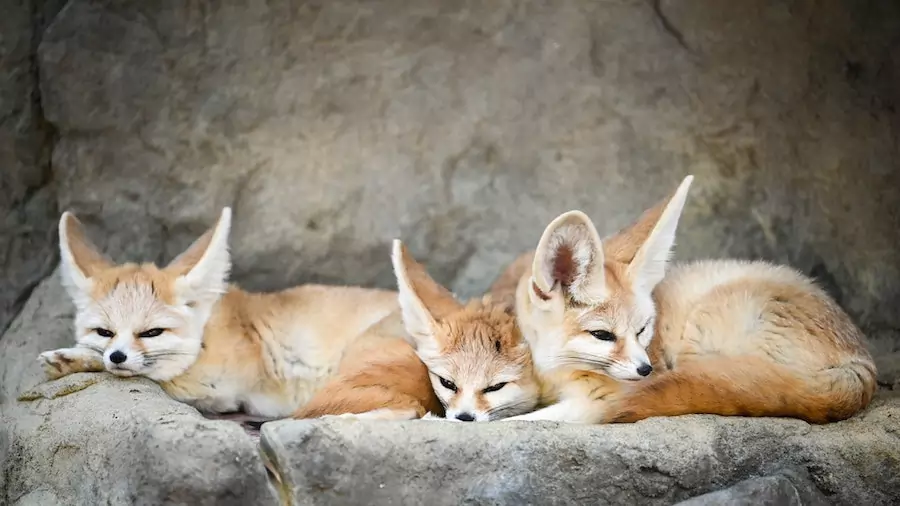Here are some great facts about fennec foxes, and fennec fox information for quick learning, quizzes, or just to amaze your friends and family.
Need some quick information about fennec foxes? I’ve divided this list into relevant categories such as behavior and hunting.
Either keep on reading or watch the video below from the Ranger Planet YouTube Channel.
Quick facts about Fennec Foxes
Physical – Facts about Fennec Foxes
1. Fennec foxes are members of the Canidae family and are in fact one of the smallest species of Canidae in the world.
2. There are two species of fennec foxes: the lesser or desert fennec and the greater or Algerian fennec.
3. They have a very similar appearance to the more common red fox, and even some domestic dogs, except they only reach about 13 inches tall and weigh between 3-6 pounds. Males are typically larger than females.
4. It’s believed that these foxes have a life span of about 10 years in their natural habitat and 13 years in captivity.
5. The ears of a fennec fox are the largest relative to the body size of any other canid.
6. These animals have nictitating membranes which protect their eyes from the harsh desert sands when they are hunting prey or looking for food at night time.
7. Fennec foxes’ furred feet help them to move easily in the sand and loosely packed desert soil where they live.
The fur on the bottom of their paws also means they won’t burn themselves on hot sand when traveling around in the desert during warmer months.
8. Their ears not only help them hear but also shield their eyes from bright sunlight and allow for body regulation (they help with temperature and can be moved to the side of the head for better hearing).
9. They use their dark coloring to warm by the sun during the day and then the heat radiates back into their bodies at night when it is cold.

Habitat – Facts about Fennec Foxes
10. The fennec fox is also known as the desert fox because it is well adapted to hot, dry climates
11. Fennec foxes can survive in some of the harshest conditions on earth, ranging from extremely cold to extremely hot temperatures.
12. They are known as desert foxes due to their ability to withstand harsh conditions such as sun exposure, high temperatures, and lack of water.
13. Fennec foxes live primarily in the Sahara desert, with some found in the surrounding regions such as Israel, Saudi Arabia, Egypt, Algeria, Tunisia, and Morocco.
14. In their dry climates, it is typical for fennec foxes to stay cool by remaining in their burrows and licking their paws, which helps cool them off and prevents dehydration.
15. The fennec fox uses its large ears to actively radiate body heat in order to stay cool in the summer months.

Behavior – Facts about Fennec Foxes
16. Fennec foxes are nocturnal, which means they’re most active at night. During this time, they’re often seen stretching and yawning (to help with blood circulation and body awakening, and preparation for the hunt).
17. A pack of fennec foxes as one family unit can contain up to 10 or even 12 individuals.
18. The typical family or “sure” of fennec foxes will dwell in an underground burrow and will generally consist of a mother, father, and around five pups.
19. Fennec foxes are very social animals and live together in a group of families as a pack. A group of foxes is called a ‘skulk’, or ‘leash’
20. Within the fennec foxes extended family units, they will often groom each other regularly and spend time cuddling with one another during sleep.
21. A group of families each has its own territorial boundaries. But they also defend those boundaries from one another at the same time. Some groups have more than 35 individuals!
22. Fennec foxes communicate with each other and keep track of one another within these small family units.
They regularly use their tails to communicate information about threats to the group; if the tail is lowered it could mean an indication of danger.
23. They will defend their territories from other fennec foxes using vocalizations, scent marks, and other displays.
Breeding and Rearing
24. Much the same as wolves, fennec foxes are monogamous and mate for life.
25. The breeding season for fennec foxes is usually only about two weeks long, once per year.
26. The Fennec fox 2 week breeding season occurs annually within January and February, resulting in a gestation period of around 50 days. Females will give birth from March to April. One annual litter generally consists of 2-5 kits.
27. The young kits nurse for four to six weeks and spend their first month with their mother in the family den.

Hunting and Diet
28. Fennec foxes are considered omnivores because they eat meat and plants.
29. Fennec foxes are known to be opportunistic feeders. This means they eat what they can when they can.
30. Rather than run in order to hunt prey, much like cats, they prefer to stalk their prey, before pouncing on their prey to ambush them instead. They achieve this with incredible accuracy.
31. These animals can travel up to 30 miles (48 kilometers) per night looking for food.
32. The fennec foxes’ large, and sensitive ears enable them to hear prey that is underground and to pick up on the sounds of small animals moving through the brush
33. Fennec foxes eat a wide variety of food. Including larvae and insects such as beetles and even locusts. They eat rodents like mice and rats, reptiles such as scorpions, birds, other animals’ eggs, fruits like dates, and some wild plants.
They will also sift through the sand with their mouths to find food buried under the ground.
When prey is scarce or if their natural food sources are buried under snow, fennec foxes survive by digging up roots to chew on. This will also then uncover more insects.
You might also like to know what foxes eat, or what eats foxes. Or perhaps more information about what arctic foxes eat.
Other Facts
34. Fennec foxes have a conservation rating of “least concern” from the International Union for Conservation of Nature (IUCN).
More wildlife help
Hopefully, this has provided you with some great facts about fennec foxes. Be sure to check out other articles on the ranger planet website. Here are some related articles to start you off…
20 Quick Facts About the Arctic Wolf – for Kids and Adults
22 Quick Facts About Coyotes You Need to Know, Coyote Facts!
Top 10 Animals That Live in the Tundra, Plus Handy A-Z List
20 Most Amazing Facts About Wombats!
